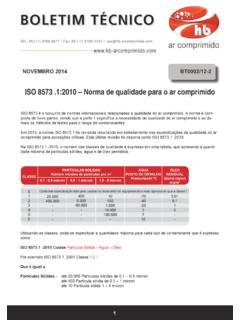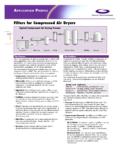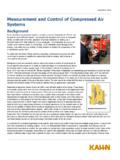Transcription of Compressed air
1 Reference numberISO 8573-1:2010(E) ISO 2010 INTERNATIONAL STANDARD ISO8573-1 Third edition2010-04-15 Compressed air Part 1: Contaminants and purity classes Air comprim Partie 1: Polluants et classes de puret Licensed to Mrs. bydlowskiISO Store order #: 10-1341155/Downloaded: 2013-07-12 Single user licence only, copying and networking prohibitedISO 8573-1:2010(E) PDF disclaimer This PDF file may contain embedded typefaces. In accordance with Adobe's licensing policy, this file may be printed or viewed but shall not be edited unless the typefaces which are embedded are licensed to and installed on the computer performing the editing. In downloading this file, parties accept therein the responsibility of not infringing Adobe's licensing policy.
2 The ISO Central Secretariat accepts no liability in this area. Adobe is a trademark of Adobe Systems Incorporated. Details of the software products used to create this PDF file can be found in the General Info relative to the file; the PDF-creation parameters were optimized for printing. Every care has been taken to ensure that the file is suitable for use by ISO member bodies. In the unlikely event that a problem relating to it is found, please inform the Central Secretariat at the address given below. COPYRIGHT PROTECTED DOCUMENT ISO 2010 All rights reserved. Unless otherwise specified, no part of this publication may be reproduced or utilized in any form or by any means, electronic or mechanical, including photocopying and microfilm, without permission in writing from either ISO at the address below or ISO's member body in the country of the requester.
3 ISO copyright office Case postale 56 CH-1211 Geneva 20 Tel. + 41 22 749 01 11 Fax + 41 22 749 09 47 E-mail Web Published in Switzerland ii ISO 2010 All rights reserved Licensed to Mrs. bydlowskiISO Store order #: 10-1341155/Downloaded: 2013-07-12 Single user licence only, copying and networking prohibitedISO 8573-1:2010(E) ISO 2010 All rights reserved iii Contents Page Foreword ..iv 1 Scope .. 1 2 Normative 1 3 Terms and definitions .. 2 4 Reference conditions .. 3 5 Compressed air purity classes .. 3 6 Designation .. 5 Annex A (informative) 7 9 Licensed to Mrs. bydlowskiISO Store order #: 10-1341155/Downloaded: 2013-07-12 Single user licence only, copying and networking prohibitedISO 8573-1:2010(E) iv ISO 2010 All rights reserved Foreword ISO (the International Organization for Standardization) is a worldwide federation of national standards bodies (ISO member bodies).
4 The work of preparing International Standards is normally carried out through ISO technical committees. Each member body interested in a subject for which a technical committee has been established has the right to be represented on that committee. International organizations, governmental and non-governmental, in liaison with ISO, also take part in the work. ISO collaborates closely with the International Electrotechnical Commission (IEC) on all matters of electrotechnical standardization. International Standards are drafted in accordance with the rules given in the ISO/IEC Directives, Part 2. The main task of technical committees is to prepare International Standards.
5 Draft International Standards adopted by the technical committees are circulated to the member bodies for voting. Publication as an International Standard requires approval by at least 75 % of the member bodies casting a vote. Attention is drawn to the possibility that some of the elements of this document may be the subject of patent rights. ISO shall not be held responsible for identifying any or all such patent rights. ISO 8573-1 was prepared by Technical Committee ISO/TC 118, Compressors and pneumatic tools, machines and equipment, Subcommittee SC 4, Compressed air purity specification and Compressed air treatment equipment. This third edition cancels and replaces the second edition (ISO 8573-1:2001), which has been technically revised.
6 It also incorporates the Technical corrigendum ISO 8573-1:2001 :2002. ISO 8573 consists of the following parts, under the general title Compressed air: Part 1: Contaminants and purity classes Part 2: Test methods for oil aerosol content Part 3: Test methods for measurement of humidity Part 4: Test methods for solid particle content Part 5: Test methods for oil vapour and organic solvent content Part 6: Test methods for gaseous contaminant content Part 7: Test method for viable microbiological contaminant content Part 8: Test methods for solid particle content by mass concentration Part 9: Test methods for liquid water content Licensed to Mrs. bydlowskiISO Store order #: 10-1341155/Downloaded: 2013-07-12 Single user licence only, copying and networking prohibitedISO 8573-1:2010(E) ISO 2010 All rights reserved v Introduction This part of ISO 8573 is the key element of the ISO 8573 series of documents, which provides a classification system for the main contaminants of a Compressed air system and identifies how other contaminants can be identified in addition to the classification system.
7 This part of ISO 8573 is supplemented by other parts that provide measurement methods for a wide range of contaminants. As an important addition to this part of ISO 8573, Annex A has been added to provide the user with guidance on a number of aspects of the classification system and topics related to the associated measurement methods. Licensed to Mrs. bydlowskiISO Store order #: 10-1341155/Downloaded: 2013-07-12 Single user licence only, copying and networking prohibitedLicensed to Mrs. bydlowskiISO Store order #: 10-1341155/Downloaded: 2013-07-12 Single user licence only, copying and networking prohibitedINTERNATIONAL STANDARD ISO 8573-1:2010(E) ISO 2010 All rights reserved 1 Compressed air Part 1: Contaminants and purity classes 1 Scope This part of ISO 8573 specifies purity classes of Compressed air with respect to particles, water and oil, independent of the location in the Compressed air system at which the air is specified or measured.
8 This part of ISO 8573 provides general information about contaminants in Compressed air systems as well as links to the other parts of ISO 8573, either for the measurement of Compressed air purity or the specification of Compressed air purity requirements. In addition to the above-mentioned contaminants of particles, water and oil, this part of ISO 8573 also identifies gaseous and microbiological contaminants. Guidance is given in Annex A as to the application of this part of ISO 8573. 2 Normative references The following referenced documents are indispensable for the application of this document. For dated references, only the edition cited applies.
9 For undated references, the latest edition of the referenced document (including any amendments) applies. ISO 7183, Compressed -air dryers Specification and testing ISO 8573-2, Compressed air Part 2: Test methods for oil aerosol content ISO 8573-3, Compressed air Part 3: Test methods for measurement of humidity ISO 8573-4, Compressed air Part 4: Test methods for solid particle content ISO 8573-5, Compressed air Part 5: Test methods for oil vapour and organic solvent content ISO 8573-6, Compressed air Part 6: Test methods for gaseous contaminant content ISO 8573-7, Compressed air Part 7: Test method for viable microbiological contaminant content ISO 8573-8, Compressed air Part 8.
10 Test methods for solid particle content by mass concentration ISO 8573-9, Compressed air Part 9: Test methods for liquid water content Licensed to Mrs. bydlowskiISO Store order #: 10-1341155/Downloaded: 2013-07-12 Single user licence only, copying and networking prohibitedISO 8573-1:2010(E) 2 ISO 2010 All rights reserved 3 Terms and definitions For the purposes of this document, the terms and definitions given in ISO 7183, ISO 8573-7 and the following apply. aerosol suspension in a gaseous medium of solid particles, liquid particles or solid and liquid particles having negligible fall-velocity/settling-velocity agglomerate group of two or more particles combined, joined or formed into a cluster by any means lubricant/coolant fluid used to remove heat and reduce friction in a compressor dewpoint temperature at which water vapour begins to condense hydrocarbon organic compound consisting mainly of hydrogen and carbon microbiological contaminants viable colony-forming units, which can be of bacteria, fungi or yeasts oil mixture of hydrocarbons composed of six or more carbon atoms (C6+)





